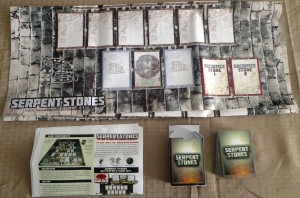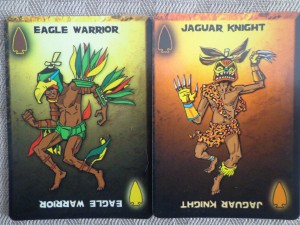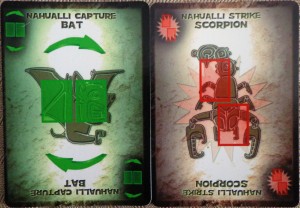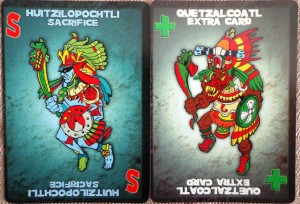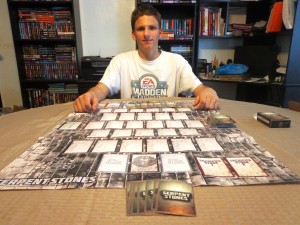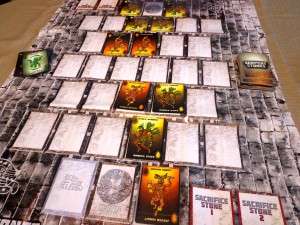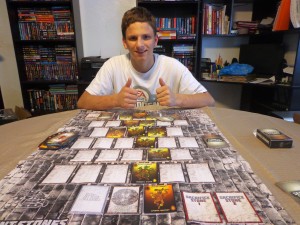Aztec priests were pretty revered back in their day, as they were often seen as a conduit between man and their gods. They were also known for their combat experience and even led armies of warriors by way of ritual combat. The Aztecs also believed in human sacrifice, utilizing their warrior houses to capture people from whoever they happened to be warring with at the time.
Serpent Stones takes all of the above and rolls it into one, quick two player card game. Each player takes on the role of a high priest in charge of a specific warrior house and attempts to be the last one standing. Before we begin, I’d like to thank Dan Yarrington and from GameSalute for reaching out to me and for introducing me to the game’s creator, Robert Harrington. I’d also like to thank David MacKenzie for answering the questions I had regarding the game. The game itself hasn’t been released yet, so please be advised that the components that you will see in this article are prototypes and some of the rules may be subject to change. Let’s take a quick look at the components and gameplay before we head into the review.
Components
Cards – The seventy-two card deck is made up of warrior cards (specifically, Jaguar Knights and Eagle Warriors), nahualli cards (capture and strike cards), and teotl cards (various cards that affect gameplay). I’ll cover all three types of cards a little more in detail later on.
Game Mat – The play area is made up of rows of card sized rectangles in which players will be laying their warrior cards. Each end of the board contains a temple stone space that each player must protect, lest they lose the game. There are also spaces for the draw pile, discard pile, and each player’s sacrifice stones…more on that in a bit.
Setup & Gameplay
The deck of cards is shuffled and players take turns drawing them one at a time until a warrior card comes up. Whatever warrior is shown on the card (either Jaguar Knight or Eagle Warrior) is the side that the drawing player will take. The deck is reshuffled and seven cards are given to each player, though each player must pick out two to discard.
Player turns are very simple in Serpent Stones. On a player’s turn, they will draw one card and then play one card (or discard one).
To start out, a player must first place a warrior card on one of their two power stones (the spaces horizontally adjacent to their temple stone). A player MUST place the appropriate warrior type (Jaguar or Eagle) based on the side they are representing on either power stone. If it is the Jaguar’s turn for example, they must place a Jaguar warrior card on one of the two power stones first.
To build an army that reaches the other side of the board, players will be laying down warrior cards (of ANY type) so that they are adjacent or linked to one another. Both players will be trying to form chains of cards that will eventually reach the other player’s temple stone. Any breaks in the chain due to attacks or game effects will temporarily label those broken from the chain as inactive. Inactive warriors cannot attack or be built off of to bring the chain forward, but they can reconnect to existing chains with the right card placement.
Players will also draw nahualli cards, which can be played to either capture or kill an adjacent enemy warrior. Capturing an opponent’s warrior will cause it to flip 180 degrees and fight for you, while killing a warrior will move it to the discard pile. Nahualli cards may attack more than just one space…which spaces the attacks occur in depends on the attack pattern shown on the card. It is possible to capture or kill more than one enemy warrior, depending on how the enemy has their cards laid out on the board.
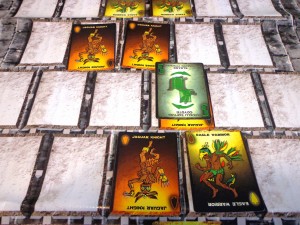
I played a capture card on an enemy warrior card, capturing it and the one above and to the left of it.
Lastly, players will be drawing teotl cards, of which there are three types. The Quetzalcoatl card allows players to draw an extra card, the Tezcatlipoca card allows a player to force their opponent to discard a card, and the Huitzilopochtli card allows a player to perform a sacrifice.
A sacrifice, to sum it up, allows the player to discard two cards…the Huitzilopochtli card goes in the standard discard pile and the other is placed in the sacrifice stone space face down. The player’s turn ends with one less card in their hand. On the next turn, the player draws as normal, plays the card on the sacrifice stone, and then plays a card from their hand. In effect, the player can play two cards on one turn. This can deplete a player’s hand, but has some strategic value. A double sacrifice can be done as well, allowing a player to play a total of three cards on one turn.
The first player to get a warrior card on the opposing player’s temple stone wins. A player can also lose IF the Tezcatlipoca card is played and your opponent has one or no cards in their hand.
The manual does a good job in explaining the rules. Since I only briefly touched on them, feel free to examine the manual in closer detail here:
The Review
Since this is a preview, I can’t comment on the quality of the components since they are prototypes…but I will say that they functioned well. There is a place for all of the cards that you’ll be playing with on the mat, so you won’t need extra space. The prototype components themselves were easy on the eyes, and I’m excited to see how the final production copies look.
For as short as player turns are and for how quick the game goes, there are a lot of strategic options available to the players. I personally like how you can form your chains in any manner you wish…that is…you can opt to build a thin chain of cards or build a solid foundation first. The thin chain of cards will get you to the other side quicker, but you risk your chain being easily broken by nahualli (strike / capture) cards. Inactive warriors are sitting ducks. Then again, wasting too many cards trying to build a foundation may not leave you with enough cards to get to the other side.
My son Vinnie (11), who has an obsession with snakes, enjoyed the game. It didn’t take him long to catch on, though I could tell he was thinking hard about how to plan ahead but unsure how to accomplish what he wanted to do. He did struggle a bit with the benefits and consequences of sacrificing. Like with any new game, strategies come over time, and I have no doubt that he’d master them in short order. Anthony (16), caught on even more quickly and made use of the sacrificing mechanic whenever he could. He often opted to build a solid foundation whereas I tried to rush across the field as quick as I could. Our games together were fast and furious and neither of us seemed like we were in the lead for long. I’d be a step away from his temple stone only to watch as he captured two of my warrior cards, halting my advance and setting me back. In the end, perseverance won the day.
I enjoyed my time with Serpent Stones as well. It’s quick and easy to play, making “dad” a happy camper during cleanup. Since it is a game that can be played quickly, it makes it a viable game to bring out with you when traveling with family or friends, assuming you have space for the mat. Since games are relatively quick, those watching that want to play won’t feel left out for long…it’s very easy to fit two or three games in under an hour’s time. If you are a fan of games like Summoner Wars, then I can see this appealing to you as well.
You can learn more about the game by visiting the official Serpent Stones website, Game Salute, and BoardGameGeek, located here:
Serpent Stones Official Website
I was able to verify with Game Salute that they are trying to get the game into retail stores before the end of the year, though there are no guarantees. Kickstarter rewards, however, are expected to be delivered on or around December 20, 2012. Either way, be on the lookout!

